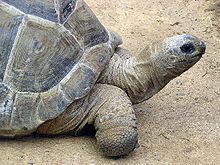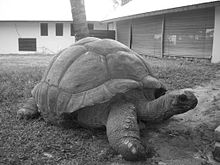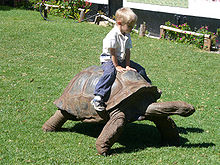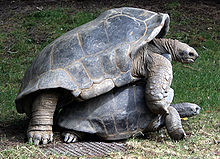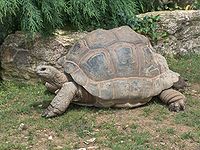- Aldabra giant tortoise
-
Aldabra giant tortoise 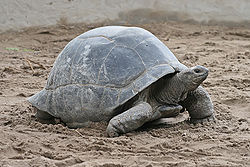
Conservation status Scientific classification Kingdom: Animalia Phylum: Chordata Class: Reptilia Order: Testudines Suborder: Cryptodira Superfamily: Testudinoidea Family: Testudinidae Genus: Aldabrachelys Species: A. gigantea Binomial name Aldabrachelys gigantea
Schweigger, 1812Dipsochelys dussumieri
The Aldabra giant tortoise (Aldabrachelys gigantea), from the islands of the Aldabra Atoll in the Seychelles, is one of the largest tortoises in the world. This species is widely referred to as Aldabrachelys gigantea but has also been placed in the genus Dipsochelys as Dipsochelys dussumieri.[1]
Contents
Anatomy and morphology
The carapace is a brown or tan color with a high domed shape. It has stocky, heavily scaled legs to support its heavy body. The neck of the Aldabra giant tortoise is very long, even for its great size, which helps the animal to exploit tree branches up to a meter from the ground as a food source.
Similar in size to the famous Galápagos giant tortoise, its carapace averages 120 centimetres (47 in) in length. The average weight of a male is around 250 kilograms (550 lb), but one male at the Fort Worth Zoological Park weighs over 360.25 kilograms (794.2 lb). Females are generally smaller than males, with average specimens measuring 90 centimetres (35 in) in length and weighing 150 kilograms (330 lb).
Range and distribution
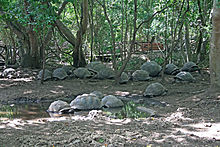 An isolated population resides on Changuu island in Zanzibar
An isolated population resides on Changuu island in Zanzibar
The main population of the Aldabra giant tortoise resides on the islands of the Aldabra Atoll in the Seychelles. The atoll has been protected from human influence and is home to some 100,000 giant tortoises, the world's largest population of the animal.[2] Another isolated population of the species resides on the island of Zanzibar, and other captive populations exist in conservation parks in Mauritius and Rodrigues. The tortoises exploit many different kinds of habitat including grasslands, low scrub, mangrove swamps, and coastal dunes.
Ecology
Habitat
A peculiar kind of habitat has co-evolved due to the grazing pressures of the tortoises: "tortoise turf," a comingling of 20+ species of grasses and herbs. Many of these distinct plants are naturally dwarfed and grow their seeds not from the tops of the plants, but closer to the ground to avoid the tortoises' close cropping jaws.
As the largest animal in its environment, the Aldabra tortoise performs a role similar to that of the elephant. Their vigorous search for food fells trees and creates pathways used by other animals.
Feeding ecology
Primarily herbivores, Aldabra giant tortoises will eat grasses, leaves, and woody plant stems. They occasionally indulge in small invertebrates and carrion, even eating the bodies of other dead tortoises. In captivity, Aldabra giant tortoises are known to enjoy fruits such as apples and bananas as well as compressed vegetable pellets.
There is little fresh water available for drinking in the tortoises' natural habitat, therefore they obtain most of their moisture from their food.
The Aldabra tortoise has two main varieties of shell. Specimens living in habitats with food available primarily on the ground have a more dome-shaped shell with front extending downward over the neck. Those living in an environment with food available higher above the ground have a more flattened top shell with the front raised to allow the neck to extend upward freely.
Tortoise turf
Tortoise turf is composed of the following plant species[3][4]:
- Bacopa monnieri
- Boerhavia elegans
- Bulbostylis basalis
- Cassia aldabrensis
- Cyperus dubius
- Cyperus ligularis
- Cyperus obtusiflorus
- Dactyloctenium pilosum
- Eragrostis decumbens
- Euphorbia prostrata
- Euphorbia stoddartii
- Evolvulus alsinoides
- Fimbristylis cymosa
- Fimbristylis ferruginea
- Hypoestes aldabrensis
- Lagrezia madagascariensis
- Lepturus repens
- Mollugo spergula
- Panicum aldabrense
- Phyllanthus maderaspatensis
- Pleurostelma cernuum
- Plumbaga aphylla
- Pycreus pumilus
- Ruellia monanthos
- Sclerodactylon macrostachyum
- Sida parvifolia
- Solanum nigrum
- Sporobolus testudinum
- Sporobolus virginicus
- Tephrosia pumila
Behavior
Aldabra tortoises are found both individually and in herds, which tend to gather mostly on open grasslands. They are most active in the mornings when they spend time browsing for food.
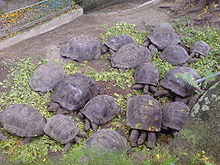 A herd of Aldabra tortoises at the Botanical Gardens, Mahé
A herd of Aldabra tortoises at the Botanical Gardens, Mahé
They dig underground burrows or rest in swamps to keep cool during the heat of the day.
While they are characteristically slow and cautious, they are capable of appreciable speed. They are also known to attempt perilous acrobatic feats, rising precariously on their hind legs to reach low branches. They risk death by tipping onto their backs and being unable to right themselves.
They are also excellent swimmers, being naturally buoyant. This factor has allowed the spread and eventual speciation of many kinds of related tortoises across the Indian Ocean.
Life history
Large tortoises are among the longest-lived animals on the planet. Some individual Aldabra giant tortoises are thought to be over 200 years of age, but this is difficult to verify because they tend to outlive their human observers. Adwaita was reputedly one of four brought by British seamen from the Seychelles Islands as gifts to Robert Clive of the British East India Company in the 18th century, and came to Calcutta Zoo in 1875. At its death in March 2006 at the Kolkata (formerly Calcutta) Zoo in India, Adwaita is reputed to have reached the longest ever measured life span of 255 years (birth year 1750). Adwaita's was determined by carbon dating his shell, making his age to be around 255 in 2006.[5] Today, Esmeralda is thought to be the oldest living giant tortoise at 170 years old, since the death of Harriet at 176, a Galapagos giant tortoise. Esmeralda is an Aldabra giant tortoise.
In captivity
The Aldabra tortoise is recently becoming more available in the pet trade. They may require a permit.[6] The price still makes them somewhat of an exclusive animal. Care for these tortoises requires a good deal of commitment. They are very powerful as adults, and can be destructive in a typical suburban setting; capable of ramming through fences and doors. Fairly expensive accommodations are necessary to contain these tortoises and keep them at a comfortable temperature throughout the year (80-95°F 27-35°C).[citation needed]
Breeding
Between February and May, females lay between 9 and 25 rubbery eggs in a shallow, dry nest. Usually less than half of the eggs are fertile. Females can produce multiple clutches of eggs in a year. After incubating for about 8 months, the tiny, independent young hatch between October and December.
In captivity, oviposition dates vary. Tulsa Zoo maintains a small herd of Aldabra tortoises and they have reproduced several times since 1999. One female typically lays eggs in November and again in January, providing the weather is warm enough to go outside for laying. The zoo also incubates their eggs artificially, keeping two separate incubators at 81 degrees F and 86 degrees F. On average, the eggs kept at the latter temperature hatch in 107 days.
Conservation
The Aldabra giant tortoise has an unusually long history of organized conservation. Albert Gunther of the British Museum, who later moved to the Natural History Museum of London (enlisting Charles Darwin and other famous scientists to help him) worked with the government of Mauritius to establish a preserve at the end of the 19th century. The related, but distinct, species of giant tortoise from the Seychelles islands (Seychelles giant tortoise Dipsochelys hololissa and Arnold's giant tortoise D. arnoldi) are the subject of a captive breeding and reintroduction program by the Nature Protection Trust of Seychelles.
Notes
- ^ Dipsochelys dussumieri GRAY 1831; P Uetz, TIGR Reptile Database
- ^ Payne, Roger (2004-04-05). "Losing Aldabra". Voyage of the Odyssey. PBS. http://www.pbs.org/odyssey/voice/20040405_vfts_transcript.html. Retrieved 2008-10-21.
- ^ Grubb 1971
- ^ Hnatiuk 1979
- ^ Risk Management Magazine, Dog Years
- ^ "Huge tortoises seized from NJ home, taken to zoo". Associated Press. http://news.yahoo.com/huge-tortoises-seized-nj-home-taken-zoo-165901818.html. Retrieved 13 September 2011.
References
- Bourn, D. Reproductive Study of Giant Tortoises on Aldabra. J. Zool., London, Vol. 182, 1977, pp. 27–38.
- Chambers, Paul. A Sheltered Life: The Unexpected History of the Giant Tortoise. John Murray (Publishers), London. 2004. ISBN 0-7195-6528-6.
- Collins, Dave. "Captive Breeding and Management of the Aldabra Tortoise". Presented to 8th International Herpetological Symposium, Jacksonville Zoo, Jacksonville, Fl., 1984.
- Gerlach, Justin. 'Giant Tortoises of the Indian Ocean' Chimiara publishers, Frankfurt. 2004
- Gibson, C.W.D. and J. Hamilton. Population Processes in a Large Herbivorous Reptile: The Giant Tortoises of Aldabra Atoll. Occologia (Berlin), Spring-Summer, 1984, pp. 230–240.
- Grubb, P. The Growth, Ecology and Population Structure of Giant Tortoises on Aldabra. Phil. Trans. Roy. Soc. Lond. B, Vol. 260, 1971, pp. 327–372.
- Hnatiuk, R.J. and L.F.H. Merton, Vegetation of Aldabra, a Reassessment. Atoll Research Bulletin No. 239, The Smithsonian Institution, 1979
- Pritchard, Peter C.H. Encyclopedia of Turtles. Neptune, New Jersey: T.F.H. Publications, Inc. Ltd., 1979.
- Spratt, David M.J. Operation Curiesue: A Conservation Programme for the Aldabra Giant Tortoise in the Republic of Seychelles. Int. Zoo Yb., Vol. 28, 1989, pp. 66–69.
- Stearns, Brett C. Captive Husbandry and Propagation of the Aldabra Giant Tortoise. Int. Zoo Yb., Vol. 27, 1988, pp. 98–103.
- Stoddart, D. R. Retrospect and Prospect of Aldabra Research. Nature, March 15, 1969, pp. 1004–1006.
- Stoddart, D. R. The Aldabra Affair. Biological Conservation, 1974, pp. 63–69.
- Swingland, Ian R. Securing the Tortoises Future. Country Life, August 30, 1984, pp. 568–569.
- Swingland, Ian R. Aldabran Giant Tortoise. The Conservation Biology of Tortoises, Occasional Papers of the IUCN Species Survival Commission (SSC), No. 5, 1989.
- Tortoise & Freshwater Turtle Specialist Group (1996). Geochelone gigantea. 2006. IUCN Red List of Threatened Species. IUCN 2006. www.iucnredlist.org. Retrieved on 11 May 2006. Listed as Vulnerable (VU D2 v2.3)
External links
- ARKive multimedia
- Sea World Animal Bytes
- Aldabra Giant Tortoise at EMY System and World Turtle Database
- Seychelles Giant Tortoise Conservation Project
- Aldabra Giant Tortoise
Tortoise family of turtles (Testudinidae) Genus Species of the Tortoise family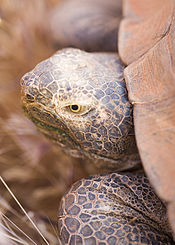
Aldabrachelys Aldabra giant tortoise1Astrochelys Angonoka tortoise · Radiated tortoiseChelonoidis Chersina Cylindraspis† Geochelone Gopherus Homopus Beaked cape tortoise · Berger's cape tortoise · Boulenger's cape tortoise · Karoo cape tortoise · Speckled padloper tortoiseIndotestudo Elongated tortoise · Forsten's tortoise · Travancore tortoiseKinixys Bell's hinge-back tortoise · Forest hinge-back tortoise · Home's hinge-back tortoise · Lobatse hinge-back tortoise · Natal hinge-back tortoise · Speke's hinge-back tortoiseMalacochersus Manouria Psammobates Pyxis Stigmochelys Testudo Phylogenetic arrangement of turtles based on turtles of the world 2010 update: annotated checklist of taxonomy, synonymy, distribution and conservation status. Key: †=extinct. 1=classification unclearOrder Testudines (turtles) Suborder SuperfamilySubfamily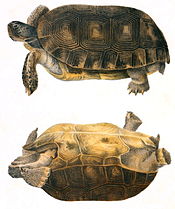
Cryptodira Chelydra · MacrochelysCaretta · Chelonia · Eretmochelys · Lepidochelys · NatatorDermochelysDermatemydidaeDermatemysStaurotypinaeClaudius · StaurotypusBatagur · Cuora · Cyclemys · Geoclemys · Geoemyda · Hardella · Heosemys · Leucocephalon · Malayemys · Mauremys · Melanochelys · Morenia · Notochelys · Orlitia · Pangshura · Rhinoclemmys · Sacalia · Siebenrockiella · VijayachelysAldabrachelys · Astrochelys · Chelonoidis · Chersina · Cylindraspis · Geochelone · Gopherus · Homopus · Indotestudo · Kinixys · Malacochersus · Manouria · Psammobates · Pyxis · Stigmochelys · TestudoTrionychiaCarettochelyidaeCarettochelysTrionychinaePleurodira ChelidinaeChelodininaeHydromedusinaePelomedusa · PelusiosPhylogenetic arrangement based on turtles of the world 2010 update: annotated checklist. Extinct turtles not included.
See also List of Testudines families
 Portal ·
Portal ·  WikiProject
WikiProjectIndividual non-fictional turtles Categories:- IUCN Red List vulnerable species
- Aldabrachelys
- Reptiles of Africa
- Fauna of Seychelles
- Megafauna of Africa
Wikimedia Foundation. 2010.


